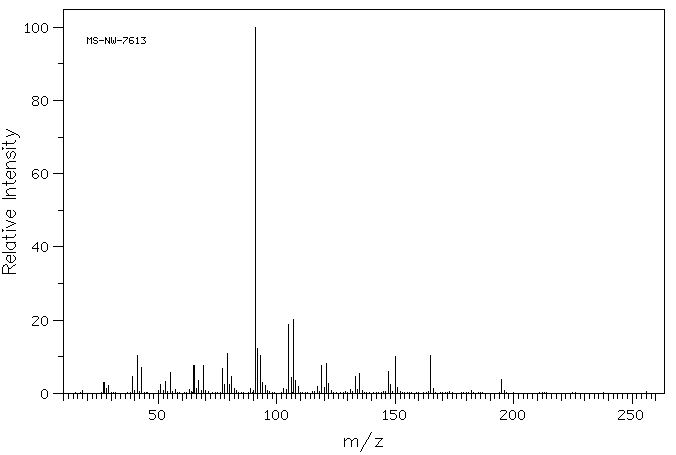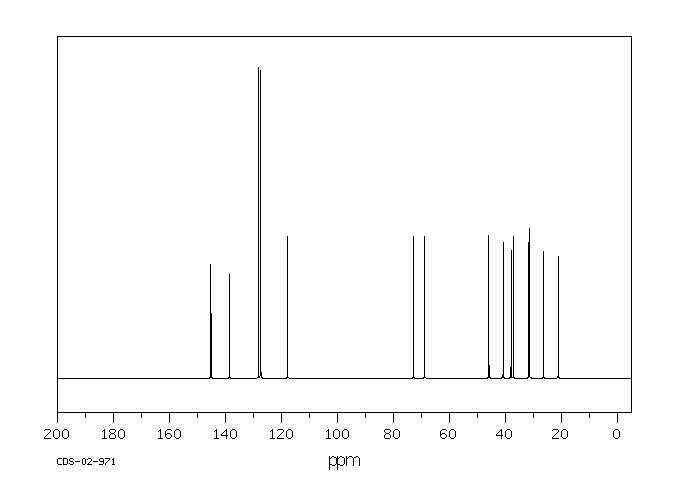(1S,5R)-2-(2-(benzyloxy)ethyl)-1,6-dimethylbicyclo[3.1.1]hept-2-ene | 934734-77-7
中文名称
——
中文别名
——
英文名称
(1S,5R)-2-(2-(benzyloxy)ethyl)-1,6-dimethylbicyclo[3.1.1]hept-2-ene
英文别名
O-benzylnopol;(1S,5R)-6,6-dimethyl-2-(2-phenylmethoxyethyl)bicyclo[3.1.1]hept-2-ene
CAS
934734-77-7
化学式
C18H24O
mdl
——
分子量
256.388
InChiKey
VZTCOMJNYWLOOB-IAGOWNOFSA-N
BEILSTEIN
——
EINECS
——
-
物化性质
-
计算性质
-
ADMET
-
安全信息
-
SDS
-
制备方法与用途
-
上下游信息
-
文献信息
-
表征谱图
-
同类化合物
-
相关功能分类
-
相关结构分类
计算性质
-
辛醇/水分配系数(LogP):4.1
-
重原子数:19
-
可旋转键数:5
-
环数:4.0
-
sp3杂化的碳原子比例:0.56
-
拓扑面积:9.2
-
氢给体数:0
-
氢受体数:1
上下游信息
-
上游原料
中文名称 英文名称 CAS号 化学式 分子量 —— (R)-(-)-nopol 149253-41-8 C11H18O 166.263
反应信息
-
作为反应物:描述:(1S,5R)-2-(2-(benzyloxy)ethyl)-1,6-dimethylbicyclo[3.1.1]hept-2-ene 在 N,N-二甲基乙酰胺 、 儿萘酚硼烷 、 苯磺酰基叠氮化物 、 反式-二叔丁基连二次硝酸酯 作用下, 以 二氯甲烷 、 N,N-二甲基甲酰胺 为溶剂, 反应 5.0h, 以78%的产率得到(1R,2R,3R,5S)-3-azido-2-[2-(benzyloxy)ethyl]-6,6-dimethylbicyclo[3.1.1]heptane参考文献:名称:A Radical Procedure for the Anti-Markovnikov Hydroazidation of Alkenes摘要:A one-pot procedure for the efficient hydroazidation of alkenes involving hydroboration with catecholborane followed by reaction with benzenesulfonyl azide in the presence of a radical initiator is described. The regioselectivity is controlled by the hydroboration step and corresponds in most cases to an anti-Markovnikov regioselectivity. This procedure is applicable to a wide range of alkenes and gives excellent results with 1,2-disubstituted and trisubstituted alkenes.DOI:10.1021/ja2054989
-
作为产物:描述:溴甲苯 、 (R)-(-)-nopol 在 sodium hydride 、 四丁基碘化铵 作用下, 以 四氢呋喃 、 mineral oil 为溶剂, 反应 24.5h, 以87%的产率得到(1S,5R)-2-(2-(benzyloxy)ethyl)-1,6-dimethylbicyclo[3.1.1]hept-2-ene参考文献:名称:A Radical Procedure for the Anti-Markovnikov Hydroazidation of Alkenes摘要:A one-pot procedure for the efficient hydroazidation of alkenes involving hydroboration with catecholborane followed by reaction with benzenesulfonyl azide in the presence of a radical initiator is described. The regioselectivity is controlled by the hydroboration step and corresponds in most cases to an anti-Markovnikov regioselectivity. This procedure is applicable to a wide range of alkenes and gives excellent results with 1,2-disubstituted and trisubstituted alkenes.DOI:10.1021/ja2054989
文献信息
-
Bromenium-Catalysed Tandem Ring Opening/Cyclisation of Vinylcyclopropanes and Vinylcyclobutanes: A Metal-Free [3+2+1]/[4+2+1] Cascade for the Synthesis of Chiral Amidines and Computational Investigation作者:Venkataraman Ganesh、Devarajulu Sureshkumar、Debasree Chanda、Srinivasan ChandrasekaranDOI:10.1002/chem.201103556日期:2012.9.24reaction has been further extended to vinylcyclobutane systems and involves a [4+2+1] cascade cyclisation with the same reagents. The versatility of the methodology has been demonstrated by careful choice of VCPs and VCBs to yield bicyclo[4.3.0]‐, ‐[4.3.1]‐ and ‐[4.4.0]amidines in enantiomerically pure form. On the basis of the experimental observations and DFT calculations, a reasonable mechanism has我们提出通过bromenium物种催化vinylcyclopropanes(VCP)的[3 + 2 + 1]级联环化的详细研究(BR δ + X δ - )原位产生的,其结果在手性二环脒在合成串联一锅操作。脒的形成涉及VCP厂商与溴开环X,然后与氯胺T进行Ritter型反应,并进行串联环化反应。该反应已进一步扩展至乙烯基环丁烷体系,并涉及使用相同试剂进行的[4 + 2 + 1]级联环化。通过仔细选择VCP和VCB可以产生对映体纯形式的双环[4.3.0]-,-[4.3.1]-和-[4.4.0] idine,证明了该方法的多功能性。在实验观察和DFT计算的基础上,提出了一种合理的机制来解释产物的形成和观察到的立体选择性。我们提出在环丙烷碳上存在π稳定的均碳正离子化是高立体选择性的原因。X)。从使用可极化连续体模型(PCM)溶剂化模型的固溶相(乙腈)计算中可以清楚地看出这一点,从中发现V
表征谱图
-
氢谱1HNMR
-
质谱MS
-
碳谱13CNMR
-
红外IR
-
拉曼Raman
-
峰位数据
-
峰位匹配
-
表征信息
同类化合物
(5β,6α,8α,10α,13α)-6-羟基-15-氧代黄-9(11),16-二烯-18-油酸
(3S,3aR,8aR)-3,8a-二羟基-5-异丙基-3,8-二甲基-2,3,3a,4,5,8a-六氢-1H-天青-6-酮
(2Z)-2-(羟甲基)丁-2-烯酸乙酯
(2S,4aR,6aR,7R,9S,10aS,10bR)-甲基9-(苯甲酰氧基)-2-(呋喃-3-基)-十二烷基-6a,10b-二甲基-4,10-dioxo-1H-苯并[f]异亚甲基-7-羧酸盐
(1aR,4E,7aS,8R,10aS,10bS)-8-[((二甲基氨基)甲基]-2,3,6,7,7a,8,10a,10b-八氢-1a,5-二甲基-氧杂壬酸[9,10]环癸[1,2-b]呋喃-9(1aH)-酮
(+)顺式,反式-脱落酸-d6
龙舌兰皂苷乙酯
龙脑香醇酮
龙脑烯醛
龙脑7-O-[Β-D-呋喃芹菜糖基-(1→6)]-Β-D-吡喃葡萄糖苷
龙牙楤木皂甙VII
龙吉甙元
齿孔醇
齐墩果醛
齐墩果酸苄酯
齐墩果酸甲酯
齐墩果酸溴乙酯
齐墩果酸二甲胺基乙酯
齐墩果酸乙酯
齐墩果酸3-O-alpha-L-吡喃鼠李糖基(1-3)-beta-D-吡喃木糖基(1-3)-alpha-L-吡喃鼠李糖基(1-2)-alpha-L-阿拉伯糖吡喃糖苷
齐墩果酸 beta-D-葡萄糖酯
齐墩果酸 beta-D-吡喃葡萄糖基酯
齐墩果酸 3-乙酸酯
齐墩果酸 3-O-beta-D-葡吡喃糖基 (1→2)-alpha-L-吡喃阿拉伯糖苷
齐墩果酸
齐墩果-12-烯-3b,6b-二醇
齐墩果-12-烯-3,24-二醇
齐墩果-12-烯-3,21,23-三醇,(3b,4b,21a)-(9CI)
齐墩果-12-烯-3,21,23-三醇,(3b,4b,21a)-(9CI)
齐墩果-12-烯-3,11-二酮
齐墩果-12-烯-2α,3β,28-三醇
齐墩果-12-烯-29-酸,3,22-二羟基-11-羰基-,g-内酯,(3b,20b,22b)-
齐墩果-12-烯-28-酸,3-[(6-脱氧-4-O-b-D-吡喃木糖基-a-L-吡喃鼠李糖基)氧代]-,(3b)-(9CI)
齐墩果-12-烯-28-酸,3,7-二羰基-(9CI)
齐墩果-12-烯-28-酸,3,21,29-三羟基-,g-内酯,(3b,20b,21b)-(9CI)
鼠特灵
鼠尾草酸醌
鼠尾草酸
鼠尾草酚酮
鼠尾草苦内脂
黑蚁素
黑蔓醇酯B
黑蔓醇酯A
黑蔓酮酯D
黑海常春藤皂苷A1
黑檀醇
黑果茜草萜 B
黑五味子酸
黏黴酮
黏帚霉酸









